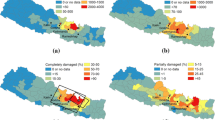Abstract
Near-fault ground motions, potentially with large amplitude and typical velocity pulses, may significantly impact the performance of a wide range of structures. The current study is aimed at evaluating the safety implications of the near-fault effect on nuclear power plant facilities designed according to the Chinese code. To this end, a set of nearfault ground motions at rock sites with typical forward-directivity effect is examined with special emphasis on several key parameters and response spectra. Spectral comparison of the selected records with the Chinese and other code design spectra was conducted. The bi-normalized response spectra in terms of different corner periods are utilized to derive nuclear design spectra. It is concluded that nuclear design spectra on rock sites derived from typical rupture directivity records are significantly influenced both by the earthquake magnitude and the rupture distance. The nuclear design spectra specified in the code needs to be adjusted to reflect the near-fault directivity effect of large earthquakes.
Similar content being viewed by others
References
Alavi B and Krawinkler H (2004), “Strengthening of Moment-resisting Frame Structures against Near-fault Ground Motion Effects,” Earthquake Engineering and Structural Dynamics, 33: 707–722.
Bray JD and Rodriguez-marek A (2004), “Characterization of Forward-directivity Ground Motions in the Near-fault Region,” Soil Dynamics and Earthquake Engineering, 24: 815–828.
CAS-N289.3 (1992), Design Procedures for Seismic Qualifications of CANDU Nuclear Power Plants, Canadian Standards Association, Rexdale, Ontario, Canada.
China Earthquake Administration (1997), Code for Seismic Design of Nuclear Power Plants (GB50267-97), Beijing.
Chopra AK (2001), Dynamics of structures: Theory and Application to Earthquake Engineering, 2nd ed. Prentice-Hall, NJ, pp. 228–238.
Chopra AK and Chintanapakdee C (2001), “Comparing Response of SDF Systems to Near-fault and Far-fault Earthquake Motions in the Context of Spectral Regions,” Earthquake Engineering and Structural Dynamics, 30: 1769–1789.
Galal K and Ghobarah A (2006), “Effect of Nearfault Earthquakes on North American Nuclear Design Spectra,” Nuclear Engineering and Design, 236: 1928–1936.
Kitada Y and Umeki Y (2004), “Near-field Earthquakes Observed Recently in Japan,” Proceedings of IAEA Workshop on Safety Significance of Near-field Earthquakes, Trieste, Italy, March 8–12, pp. 28.
Malhotra PK (2003), “Strong-motion Records for Site-Specific Analysis,” Earthquake Spectra, 19(3): 557–578.
Mavroeidis GP, Dong G and Papageorgiou AS (2004), “Near-fault Ground Motions, and the Response of Elastic and Inelastic Single-degree-of-freedom (SDOF) Systems,” Earthquake Engineering and Structural Dynamics, 33: 1023–1049.
Newmark NM and Hall WJ (1982), “Earthquake Spectra and Design,” Earthquake Engineering Research Institute, Berkeley, Calif., pp. 30–40.
Somerville PG (2003), “Magnitude Scaling of the Near Fault Rupture Directivity Pulse,” Physics of the Earth and Planetary Interiors, 137: 201–212.
US-NUREG/CR 6728 (2001), Regulatory Guidance on Design Ground Motions, US Nuclear Regulatory Commission NRC, Washington, DC, USA.
Xu Longjun, Rodriguez-Marek A and Xie Lili (2006), “Design Spectra Including Effect of Rupture-Directivity in Near-fault Region,” Earthquake Engineering and Engineering Vibration, 5(2): 159–170.
Xu Longjun and Xie Lili (2004), “Bi-normalized Response Spectral Characteristics of the Chi-Chi Earthquake,” Earthquake Engineering and Engineering Vibration, 3(2): 147–155.
Xu Longjun and Xie Lili (2007), “Near-fault Ground Motion Bi-normalized Pseudo-velocity Spectra and Its Application,” Acta Seismologica Sinica, 20(2): 245–250.
Author information
Authors and Affiliations
Corresponding author
Additional information
Supported by: National Natural Science Foundation of China Under Grant No. 50808168; Ministry of Science and Technology of Weihai Under Grant No. 2008087; Beijing Natural Science Foundation Under Grant No. 8092029
Rights and permissions
About this article
Cite this article
Xu, L., Yang, S. & Xie, L. Response spectra for nuclear structures on rock sites considering the near-fault directivity effect. Earthq. Eng. Eng. Vib. 9, 357–365 (2010). https://doi.org/10.1007/s11803-010-0020-6
Received:
Accepted:
Published:
Issue Date:
DOI: https://doi.org/10.1007/s11803-010-0020-6




